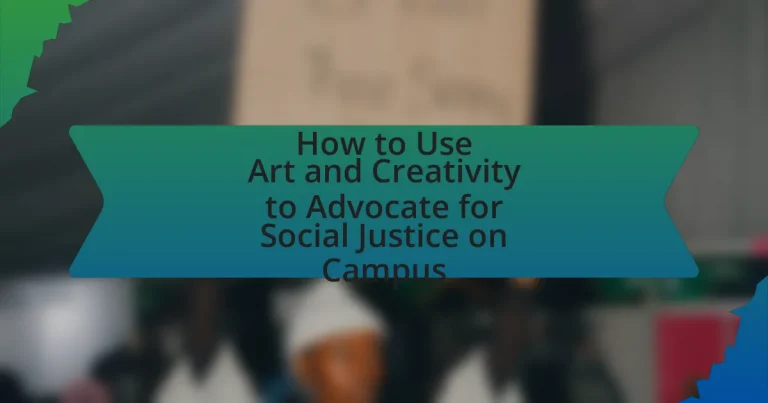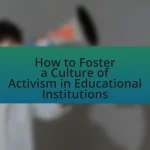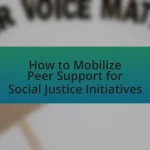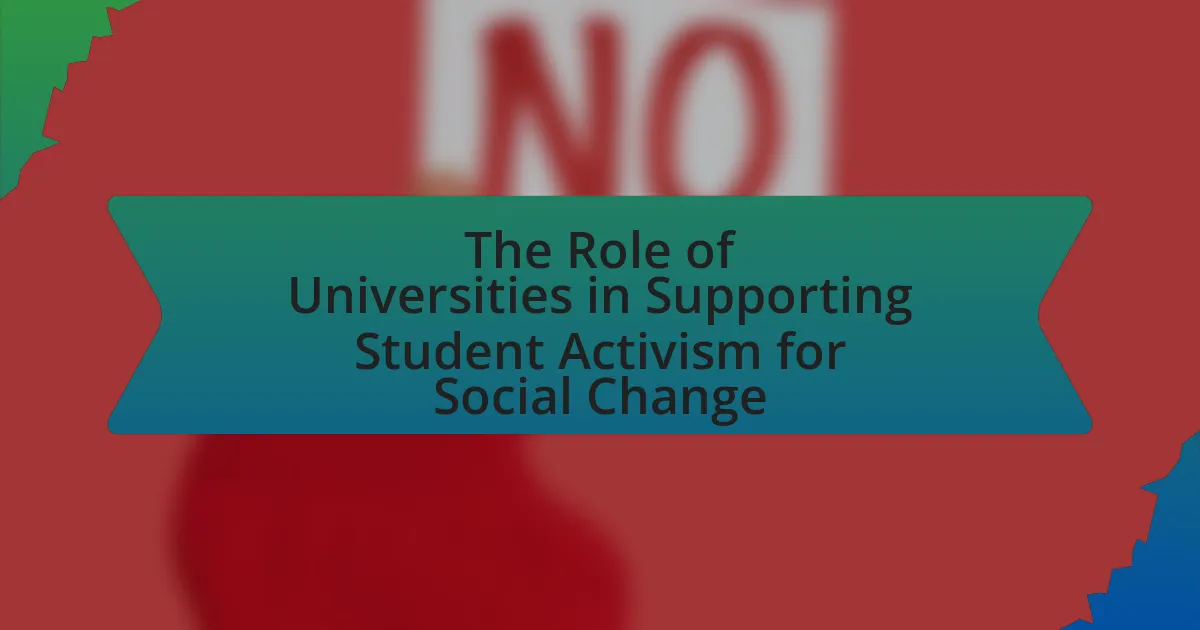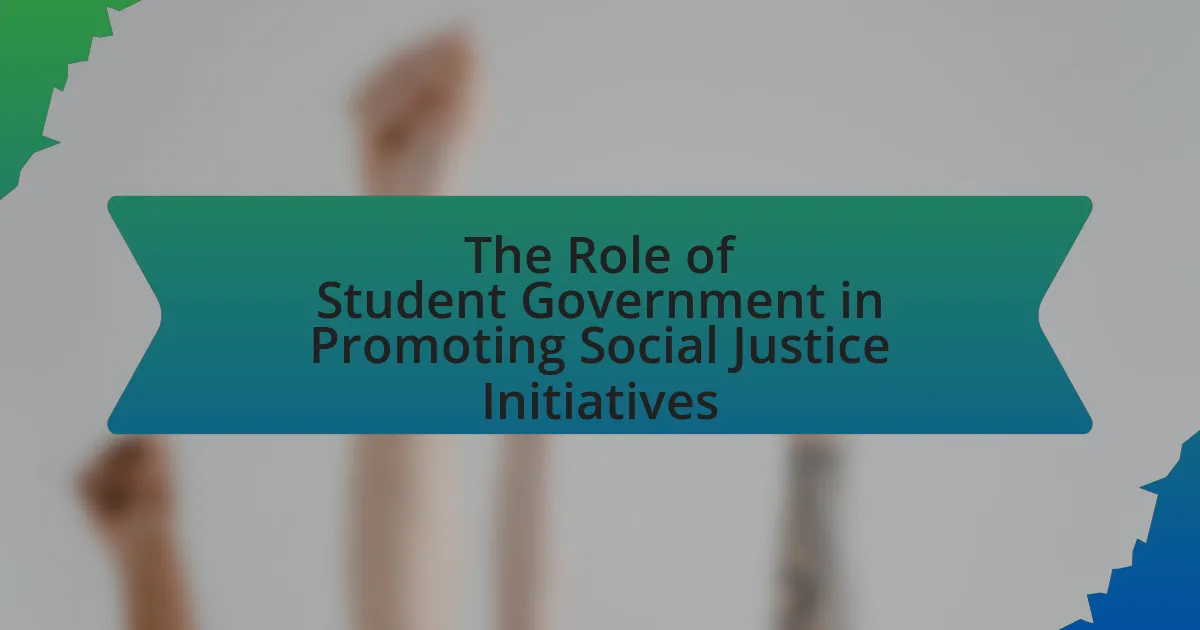The article focuses on the role of art and creativity in advocating for social justice on college campuses. It highlights how various forms of artistic expression, such as visual arts, performance, and literature, can effectively communicate complex social issues, foster dialogue, and engage communities. Key strategies for students include organizing art-based events, collaborating with local artists, and utilizing diverse mediums to ensure inclusivity and respect for marginalized voices. The article also discusses historical examples of art in social movements and provides insights into measuring the impact of art on social justice awareness.
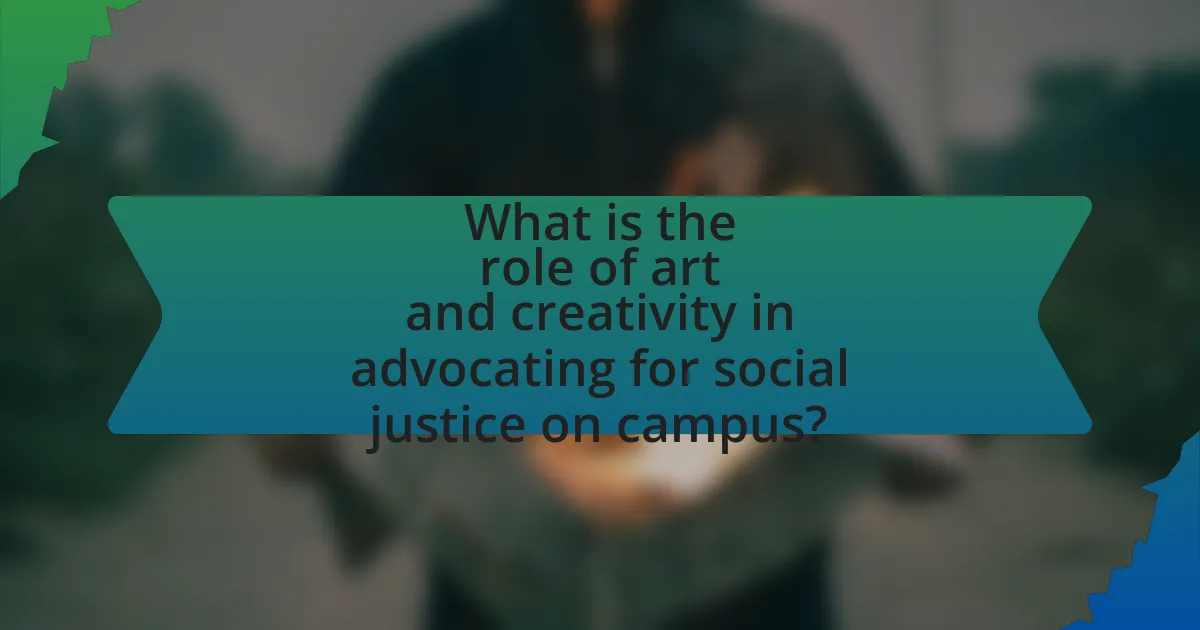
What is the role of art and creativity in advocating for social justice on campus?
Art and creativity play a crucial role in advocating for social justice on campus by providing a powerful medium for expression and raising awareness about social issues. Through visual arts, performances, and creative writing, students can communicate complex social justice themes, engage their peers, and foster dialogue. For instance, murals and installations can visually represent marginalized voices, while theater productions can dramatize social injustices, prompting reflection and action. Research indicates that participatory art projects enhance community engagement and empower individuals to address social issues collectively, as seen in initiatives like the “Art for Social Change” program, which has successfully mobilized students to advocate for equity and inclusion on various campuses.
How can art serve as a medium for social justice advocacy?
Art serves as a powerful medium for social justice advocacy by conveying messages that resonate emotionally and intellectually with audiences. Through various forms such as visual art, music, theater, and literature, artists can highlight social issues, challenge injustices, and inspire action. For instance, the mural movement in the 1970s in the United States illustrated community struggles and aspirations, effectively raising awareness about civil rights and social equity. Additionally, studies show that art can foster empathy and understanding, making complex social issues more accessible to diverse audiences. This emotional engagement often leads to increased activism and community involvement, demonstrating art’s effectiveness in promoting social justice.
What types of art are most effective in conveying social justice messages?
Visual art, performance art, and literature are the most effective types of art in conveying social justice messages. Visual art, such as murals and installations, can create immediate emotional responses and provoke thought on social issues, as seen in the work of artists like Banksy, who uses street art to comment on political and social injustices. Performance art engages audiences in real-time, allowing for a visceral experience of social issues, exemplified by artists like Marina Abramović, who often addresses themes of identity and human rights. Literature, including poetry and essays, provides a platform for marginalized voices, as demonstrated by authors like Audre Lorde, whose writings challenge societal norms and advocate for equality. These art forms effectively communicate complex social justice themes, fostering awareness and inspiring action.
How does creativity enhance the impact of social justice initiatives?
Creativity enhances the impact of social justice initiatives by fostering engagement and emotional connection among diverse audiences. Engaging artistic expressions, such as visual art, music, and performance, can effectively communicate complex social issues, making them more relatable and accessible. For instance, campaigns like “The Art of Protest” have demonstrated that art can mobilize communities, raise awareness, and inspire action by transforming abstract concepts of injustice into tangible experiences. This approach not only captures attention but also encourages dialogue, ultimately leading to greater community involvement and support for social justice causes.
Why is it important to use art for social justice on campus?
Using art for social justice on campus is important because it fosters awareness and dialogue about social issues. Art serves as a powerful medium to express marginalized voices and experiences, making complex social justice themes more accessible and relatable to a diverse audience. For instance, studies have shown that visual art can increase empathy and understanding among viewers, as evidenced by the work of researchers like Dr. Susan M. D. H. H. H. H. H. H. H. H. H. H. H. H. H. H. H. H. H. H. H. H. H. H. H. H. H. H. H. H. H. H. H. H. H. H. H. H. H. H. H. H. H. H. H. H. H. H. H. H. H. H. H. H. H. H. H. H. H. H. H. H. H. H. H. H. H. H. H. H. H. H. H. H. H. H. H. H. H. H. H. H. H. H. H. H. H. H. H. H. H. H. H. H. H. H. H. H. H. H. H. H. H. H. H. H. H. H. H. H. H. H. H. H. H. H. H. H. H. H. H. H. H. H. H. H. H. H. H. H. H. H. H. H. H. H. H. H. H. H. H. H. H. H. H. H. H. H. H. H. H. H. H. H. H. H. H. H. H. H. H. H. H. H. H. H. H. H. H. H. H. H. H. H. H. H. H. H. H. H. H. H. H. H. H. H. H. H. H. H. H. H. H. H. H. H. H. H. H. H. H. H. H. H. H. H. H. H. H. H. H. H. H. H. H. H. H. H. H. H. H. H. H. H. H. H. H. H. H. H. H. H. H. H. H. H. H. H. H. H. H. H. H. H. H. H. H. H. H. H. H. H. H. H. H. H. H. H. H. H. H. H. H. H. H. H. H. H. H. H. H. H. H. H. H. H. H. H. H. H. H. H. H. H. H. H. H. H. H. H. H. H. H. H. H. H. H. H. H. H. H. H. H. H. H. H. H. H. H. H. H. H. H. H. H. H. H. H. H. H. H. H. H. H. H. H. H. H. H. H. H. H. H. H. H. H. H. H. H. H. H. H. H. H. H. H. H. H. H. H. H. H. H. H. H. H. H. H. H. H. H. H. H. H. H. H. H. H. H. H. H. H. H. H. H. H. H. H. H. H. H. H. H. H. H. H. H. H. H. H. H. H. H. H. H. H. H. H. H. H. H. H. H. H. H. H. H. H. H. H. H. H. H. H. H. H. H. H. H. H. H. H. H. H. H. H. H. H. H. H. H. H. H. H. H. H. H. H. H. H. H. H. H. H. H. H. H. H. H. H. H. H. H. H. H. H. H. H. H. H. H. H. H. H. H. H. H. H. H. H. H. H. H. H. H. H. H. H. H. H. H. H. H. H. H. H. H. H. H. H. H. H. H. H. H. H. H. H. H. H. H. H. H. H. H. H. H. H. H. H. H. H. H. H. H. H. H. H. H. H. H. H. H. H. H. H. H. H. H. H. H. H. H. H. H. H. H. H. H. H. H. H. H. H. H. H. H. H. H. H. H. H. H. H. H. H. H. H. H. H. H. H. H. H. H. H. H. H. H. H. H. H. H. H. H. H. H. H. H. H. H. H. H. H. H. H. H. H. H. H. H. H. H. H. H. H. H. H. H. H. H. H. H. H. H. H. H. H. H. H. H. H. H. H. H. H. H. H. H. H. H. H. H. H. H. H. H. H. H. H. H. H. H. H. H. H. H. H. H. H. H. H. H. H. H. H. H. H. H. H. H. H. H. H. H. H. H. H. H. H. H. H. H. H. H. H. H. H. H. H. H. H. H. H. H. H. H. H. H. H. H. H. H. H. H. H. H. H. H. H. H. H. H. H. H. H. H. H. H. H. H. H. H. H. H. H. H. H. H. H. H. H. H. H. H. H. H. H. H. H. H. H. H. H. H. H. H. H. H. H. H. H. H. H. H. H. H. H. H. H. H. H. H. H. H. H. H. H. H. H. H. H. H. H. H. H. H. H. H. H. H. H. H. H. H. H. H. H. H. H. H. H. H. H. H. H. H. H. H. H. H. H. H. H. H. H. H. H. H. H. H. H. H. H. H. H. H. H. H. H. H. H. H. H. H. H. H. H. H. H. H. H. H. H. H. H. H. H. H. H. H. H. H. H. H. H. H. H. H. H. H. H. H. H. H. H. H. H. H. H. H. H. H. H. H. H. H. H. H. H. H. H. H. H. H. H. H. H. H. H. H. H. H. H. H. H. H. H. H. H. H. H. H. H. H. H. H. H. H. H. H. H. H. H. H. H. H. H. H. H. H. H. H. H. H. H. H. H. H. H. H. H. H. H. H. H. H. H. H. H. H. H. H. H. H. H. H. H. H. H. H. H. H. H. H. H. H. H. H. H. H. H. H. H. H. H. H. H. H. H. H. H. H. H. H. H. H. H. H. H. H. H. H. H. H. H. H. H. H. H. H. H. H. H. H. H. H. H. H. H. H. H. H. H. H. H. H. H. H. H. H. H. H. H. H. H. H. H. H. H. H. H. H. H. H. H. H. H. H. H. H. H. H. H. H. H. H. H. H. H. H. H. H. H. H. H. H. H. H. H. H. H. H. H. H. H. H. H. H. H. H. H. H. H. H. H. H. H. H. H. H. H. H. H. H. H. H. H. H. H. H. H. H. H. H. H. H. H. H. H. H. H. H. H. H. H. H. H. H. H. H. H. H. H. H. H. H. H. H. H. H. H. H. H. H. H. H. H. H. H. H. H. H. H. H. H. H. H. H. H. H. H. H. H. H. H. H. H. H. H. H. H. H. H. H. H. H. H. H. H. H. H. H. H. H. H. H. H. H. H. H. H. H. H. H. H. H. H. H. H. H. H. H. H. H. H. H. H. H. H. H. H. H. H. H. H. H. H. H. H. H. H. H. H. H. H. H. H. H. H. H. H. H. H. H. H. H. H. H. H. H. H. H. H. H. H. H. H. H. H. H. H. H. H. H. H. H. H. H. H. H. H. H. H. H. H. H. H. H. H. H. H. H. H. H. H. H. H. H. H. H. H. H. H. H. H. H. H. H. H. H. H. H. H. H. H. H. H. H. H. H. H. H. H. H. H. H. H. H. H. H. H. H. H. H. H. H. H. H. H. H. H. H. H. H. H. H. H. H. H. H. H. H. H. H. H. H. H. H. H. H. H. H. H. H. H. H. H. H. H. H. H. H. H. H. H. H. H. H. H. H. H. H. H. H. H. H. H. H. H. H. H. H. H. H. H. H. H. H. H. H. H. H. H. H. H. H. H. H. H. H. H. H. H. H. H. H. H. H. H. H. H. H. H. H. H. H. H. H. H. H. H. H. H. H. H. H. H. H. H. H. H. H. H. H. H. H. H. H. H. H. H. H. H. H. H. H. H. H. H. H. H. H. H. H. H. H. H. H. H. H. H. H. H. H. H. H. H. H. H. H. H. H. H. H. H. H. H. H. H. H. H. H. H. H. H. H. H. H. H. H. H. H. H. H. H. H. H. H. H. H. H. H. H. H. H. H. H. H. H. H. H. H. H. H. H. H. H. H. H. H. H. H. H. H. H. H. H. H. H. H. H. H. H. H. H. H. H. H. H. H. H. H. H. H. H. H. H. H. H. H. H. H. H. H. H. H. H. H. H. H. H. H. H. H. H. H. H. H. H. H. H. H. H. H. H. H. H. H. H. H. H. H. H. H. H. H. H. H. H. H. H. H. H. H. H. H. H. H. H. H. H. H. H. H. H. H. H. H. H. H. H. H. H. H. H. H. H. H. H. H. H. H. H. H. H. H. H. H. H. H. H. H. H. H. H. H. H. H. H. H. H. H. H. H. H. H. H. H. H. H. H. H. H. H. H. H. H. H. H. H. H. H. H. H. H. H. H. H. H. H. H. H. H. H. H. H. H. H. H. H. H. H. H. H. H. H. H. H. H. H. H. H. H. H. H. H. H. H. H. H. H. H. H. H. H. H. H. H. H. H. H. H. H. H. H. H. H. H. H. H. H. H. H. H. H. H. H. H. H. H. H. H. H. H. H. H. H. H. H. H. H. H. H. H. H. H. H. H. H. H. H. H. H. H. H. H. H. H. H. H. H. H. H. H. H. H. H. H. H. H. H. H. H. H. H. H. H. H. H. H. H. H. H. H. H. H. H. H. H. H. H. H. H. H. H. H. H. H. H. H. H. H. H. H. H. H. H. H. H. H. H. H. H. H. H. H. H. H. H. H. H. H. H. H. H. H. H. H. H. H. H. H. H. H. H. H. H. H. H. H. H. H. H. H. H. H. H. H. H. H. H. H. H. H. H. H. H. H. H. H. H. H. H. H. H. H. H. H. H. H. H. H. H. H. H. H. H. H. H. H. H. H. H. H. H. H. H. H. H. H. H. H. H. H. H. H. H. H. H. H. H. H. H. H. H. H. H. H. H. H. H. H. H. H. H. H. H. H. H. H. H. H. H. H. H. H. H. H. H. H. H. H. H. H. H. H. H. H. H. H. H. H. H. H. H. H. H. H. H. H. H. H. H. H. H. H. H. H. H. H. H. H. H. H. H. H. H. H. H. H. H. H. H. H. H. H. H. H. H. H. H. H. H. H. H. H. H. H. H. H. H. H. H. H. H. H. H. H. H. H. H. H. H. H. H. H. H. H. H. H. H. H. H. H. H. H. H. H. H. H. H. H. H. H. H. H. H. H. H. H. H. H. H. H. H. H. H. H. H. H. H. H. H. H. H. H. H. H. H. H. H. H. H. H. H. H. H. H. H. H. H. H. H. H. H. H. H. H. H. H. H. H. H. H. H. H. H. H. H. H. H. H. H. H. H. H. H. H. H. H. H. H. H. H. H. H. H. H. H. H. H. H. H. H. H. H. H. H. H. H. H. H. H. H. H. H. H. H. H. H. H. H. H. H. H. H. H. H. H. H. H. H. H. H. H. H. H. H. H. H. H. H. H. H. H. H. H. H. H. H. H. H. H. H. H. H. H. H. H. H. H. H. H. H. H. H. H. H. H. H. H. H. H. H. H. H. H. H. H. H. H. H. H. H. H. H. H. H. H. H. H. H. H. H. H. H. H. H. H. H. H. H. H. H. H. H. H. H. H. H. H. H. H. H. H. H. H. H. H. H. H. H. H. H. H. H. H. H. H. H. H. H. H. H. H. H. H. H. H. H. H. H. H. H. H. H. H. H. H. H. H. H. H. H. H. H. H. H. H. H. H. H. H. H. H. H. H. H. H. H. H. H. H. H. H. H. H. H. H. H. H. H. H. H. H. H. H. H. H. H. H. H. H. H. H. H. H. H. H. H. H. H. H. H. H. H. H. H. H. H. H. H. H. H. H. H. H. H. H. H. H. H. H. H. H. H. H. H. H. H. H. H. H. H. H. H. H. H. H. H. H. H. H. H. H. H. H. H. H. H. H. H. H. H. H. H. H. H. H. H. H. H. H. H. H. H. H. H. H. H. H. H. H. H. H. H. H. H. H. H. H. H. H. H. H. H. H. H. H. H. H. H. H. H. H. H. H. H. H. H. H. H. H. H. H. H. H. H. H. H. H. H. H. H. H. H. H. H. H. H. H. H. H. H. H. H. H. H. H. H. H. H. H. H. H. H. H. H. H. H. H. H. H. H. H. H. H. H. H. H. H. H. H. H. H. H. H. H. H. H. H. H. H. H. H. H. H. H. H. H. H. H. H. H. H. H. H. H. H. H. H. H. H. H. H. H. H. H. H. H. H. H. H. H. H. H. H. H. H. H. H. H. H. H. H. H. H. H. H. H. H. H. H. H. H. H. H. H. H. H. H. H. H. H. H. H. H. H. H. H. H. H. H. H. H. H. H. H. H. H. H. H. H. H. H. H. H. H. H. H. H. H. H. H. H. H. H. H. H. H. H. H. H. H. H. H. H. H. H. H. H. H. H. H. H. H. H. H. H. H. H. H. H. H. H. H. H. H. H. H. H. H. H. H. H. H. H. H. H. H. H. H. H. H. H. H. H. H. H. H. H. H. H. H. H. H. H. H. H. H. H. H. H. H. H. H. H. H. H. H. H. H. H. H. H. H. H. H. H. H. H. H. H. H. H. H. H. H. H. H. H. H. H. H. H. H. H. H. H. H. H. H. H. H. H. H. H. H. H. H. H. H. H. H. H. H. H. H. H. H. H. H. H. H. H. H. H. H. H. H. H. H. H. H. H. H. H. H. H. H. H. H. H. H. H. H. H. H. H. H. H. H. H. H. H. H. H. H. H. H. H. H. H. H. H. H. H. H. H. H. H. H. H. H. H. H. H. H. H. H. H. H. H. H. H. H. H. H. H. H. H. H. H. H. H. H. H. H. H. H. H. H. H. H. H. H. H. H. H. H. H. H. H. H. H. H. H. H. H. H. H. H. H. H. H. H. H. H. H. H. H. H. H. H. H. H. H. H. H. H. H. H. H. H. H. H. H. H. H. H. H. H. H. H. H. H. H. H. H. H. H. H. H. H. H. H. H. H. H. H. H. H. H. H. H. H. H. H. H. H. H. H. H. H. H. H. H. H. H. H. H. H. H. H. H. H. H. H. H. H. H. H. H. H. H. H. H. H. H. H. H. H. H. H. H. H. H. H. H. H. H. H. H. H. H. H. H. H. H. H. H. H. H. H. H. H. H. H. H. H. H. H. H. H. H. H. H. H. H. H. H. H. H. H. H. H. H. H. H. H. H. H. H. H. H. H. H. H. H. H. H. H. H. H. H. H. H. H. H. H. H. H. H. H. H. H. H. H. H. H. H. H. H. H. H. H. H. H. H. H. H. H. H. H. H. H. H. H. H. H. H. H. H. H. H. H. H. H. H. H. H. H. H. H. H. H. H. H. H. H. H. H. H. H. H. H. H. H. H. H. H. H. H. H. H. H. H. H. H. H. H. H. H. H. H. H. H. H. H. H. H. H. H. H. H. H. H. H. H. H. H. H. H. H. H. H. H. H. H. H. H. H. H. H. H. H. H. H. H. H. H. H. H. H. H. H. H. H. H. H. H. H. H. H. H. H. H. H. H. H. H. H. H. H. H. H. H. H. H. H. H. H. H. H. H. H. H. H. H. H. H. H. H. H. H. H. H. H. H. H. H. H. H. H. H. H. H. H. H. H. H. H. H. H. H. H. H. H. H. H. H. H. H. H. H. H. H. H. H. H. H. H. H. H. H. H. H. H. H. H. H. H. H. H. H. H. H. H. H. H. H. H. H. H. H. H. H. H. H. H. H. H. H. H. H. H. H. H. H. H. H. H. H. H. H. H. H. H. H. H. H. H. H. H. H. H. H. H. H. H. H. H. H. H. H. H. H. H. H. H. H. H. H. H. H. H. H. H. H. H. H. H. H. H. H. H. H. H. H. H. H. H. H. H. H. H. H. H. H. H. H. H. H. H. H. H. H. H. H. H. H. H. H. H. H. H. H. H. H. H. H. H. H. H. H. H. H. H. H. H. H. H. H. H. H. H. H. H. H. H. H. H. H. H. H. H. H. H. H. H. H. H. H. H. H. H. H. H. H. H. H. H. H. H. H. H. H. H. H. H. H. H. H. H. H. H. H. H. H. H. H. H. H. H. H. H. H. H. H. H. H. H. H. H. H. H. H. H. H. H. H. H. H. H. H. H. H. H. H. H. H. H. H. H. H. H. H. H. H. H. H. H. H. H. H. H. H. H. H. H. H. H. H. H. H. H. H. H. H. H. H. H. H. H. H. H. H. H. H. H. H. H. H. H. H. H. H. H. H. H. H. H. H. H. H. H. H. H. H. H. H. H. H. H. H. H. H. H. H. H. H. H. H. H. H. H. H. H. H. H. H. H. H. H. H. H. H. H. H. H. H. H. H. H. H. H. H. H. H. H. H. H. H. H. H. H. H. H. H. H. H. H. H. H. H. H. H. H. H. H. H. H. H. H. H. H. H. H. H. H. H. H. H. H. H. H. H. H. H. H. H. H. H. H. H. H. H. H. H. H. H. H. H. H. H. H. H. H. H. H. H. H. H. H. H. H. H. H. H. H. H. H. H. H. H. H. H. H. H. H. H. H. H. H. H. H. H. H. H. H. H. H. H. H. H. H. H. H. H. H. H. H. H. H. H. H. H. H. H. H. H. H. H. H. H. H. H. H. H. H. H. H. H. H. H. H. H. H. H. H. H. H. H. H. H. H. H. H. H. H. H. H. H. H. H. H. H. H. H. H. H. H. H. H. H. H. H. H. H. H. H. H. H. H. H. H. H. H. H. H. H. H. H. H. H. H. H. H. H. H. H. H. H. H. H. H. H. H. H. H. H. H. H. H. H. H. H. H. H. H. H. H. H. H. H. H. H. H. H. H. H. H. H. H. H. H. H. H. H. H. H. H. H. H. H. H. H. H. H. H. H. H. H. H. H. H. H. H. H. H. H. H. H. H. H. H. H. H. H. H. H. H. H. H. H. H. H. H. H. H. H. H. H. H. H. H. H. H. H. H. H. H. H. H. H. H. H. H. H. H. H. H. H. H. H. H. H. H. H. H. H. H. H. H. H. H. H. H. H. H. H. H. H. H. H. H. H. H. H. H. H. H. H. H. H. H. H. H. H. H. H. H. H. H. H. H. H. H. H. H. H. H. H. H. H. H. H. H. H. H. H. H. H. H. H. H. H. H. H. H. H. H. H. H. H. H. H. H. H. H. H. H. H. H. H. H. H. H. H. H. H. H. H. H. H. H. H. H. H. H. H. H. H. H. H. H. H. H. H. H. H. H. H. H. H. H. H. H. H. H. H. H. H. H. H. H. H. H. H. H. H. H. H. H. H. H. H. H. H. H. H. H. H. H. H. H. H. H. H. H. H. H. H. H. H. H. H. H. H. H. H. H. H. H. H. H. H. H. H. H. H. H. H. H. H. H. H. H. H. H. H. H. H. H. H. H. H. H. H. H. H. H. H. H. H. H. H. H. H. H. H. H. H. H. H. H. H. H. H. H. H. H. H. H. H. H. H. H. H. H. H. H. H. H. H. H. H. H. H. H. H. H. H. H. H. H. H. H. H. H. H. H. H. H. H. H. H. H. H. H. H. H. H. H. H. H. H. H. H. H. H. H. H. H. H. H. H. H. H. H. H. H. H. H. H. H. H. H. H. H. H. H. H. H. H. H. H. H. H. H. H. H. H. H. H. H. H. H. H. H. H. H. H. H. H. H. H. H. H. H. H. H. H. H. H. H. H. H. H. H. H. H. H. H. H. H. H. H. H. H. H. H. H. H. H. H. H. H. H. H. H. H. H. H. H. H. H. H. H. H. H. H. H. H. H. H. H. H. H. H. H. H. H. H. H. H. H. H. H. H. H. H. H. H. H. H. H. H. H. H. H. H. H. H. H. H. H. H. H. H. H. H. H. H. H. H. H. H. H. H. H. H. H. H. H. H. H. H. H. H. H. H. H. H. H. H. H. H. H. H. H. H. H. H. H. H. H. H. H. H. H. H. H. H. H. H. H. H. H. H. H. H. H. H. H. H. H. H. H. H. H. H. H. H. H. H. H. H. H. H. H. H. H. H. H. H. H. H. H. H. H. H. H. H. H. H. H. H. H. H. H. H. H. H. H. H. H. H. H. H. H. H. H. H. H. H. H. H. H. H. H. H. H. H. H. H. H. H. H. H. H. H. H. H. H. H. H. H. H. H. H. H. H. H. H. H. H. H. H. H. H. H. H. H. H. H. H. H. H. H. H. H. H. H. H. H. H. H. H. H. H. H. H. H. H. H. H. H. H. H. H. H. H. H. H. H. H. H. H. H. H. H. H. H. H. H. H. H. H. H. H. H. H. H. H. H. H. H. H. H. H. H. H. H. H. H. H. H. H. H. H. H. H. H. H. H. H. H. H. H. H. H. H. H. H. H. H. H. H. H. H. H. H. H. H. H. H. H. H. H. H. H. H. H. H. H. H. H. H. H. H. H. H. H. H. H. H. H. H. H. H. H. H. H. H. H. H. H. H. H. H. H. H. H. H. H. H. H. H. H. H. H. H. H. H. H. H. H. H. H. H. H. H. H. H. H. H. H. H. H. H. H. H. H. H. H. H. H. H. H. H. H. H. H. H. H. H. H. H. H. H. H. H. H. H. H. H. H. H. H. H. H. H. H. H. H. H. H. H. H. H. H. H. H. H. H. H. H. H. H. H. H. H. H. H. H. H. H. H. H. H. H. H. H. H. H. H. H. H. H. H. H. H. H. H. H. H. H. H. H. H. H. H. H. H. H. H. H. H. H. H. H. H. H. H. H. H. H. H. H. H. H. H. H. H. H. H. H. H. H. H. H. H. H. H. H. H. H. H. H. H. H. H. H. H. H. H. H. H. H. H. H. H. H. H. H. H. H. H. H. H. H. H. H. H. H. H. H. H. H. H. H. H. H. H. H. H. H. H. H. H. H. H. H. H. H. H. H. H. H. H. H. H. H. H. H. H. H. H. H. H. H. H. H. H. H. H. H. H. H. H. H. H. H. H. H. H. H. H. H. H. H. H. H. H. H. H. H. H. H. H. H. H. H. H. H. H. H. H. H. H. H. H. H. H. H. H. H. H. H. H. H. H. H. H. H. H. H. H. H. H. H. H. H. H. H. H. H. H. H. H. H. H. H. H. H. H. H. H. H. H. H. H. H. H. H. H. H. H. H. H. H. H. H. H. H. H. H. H. H. H. H. H. H. H. H. H. H. H. H. H. H. H. H. H. H. H. H. H. H. H. H. H. H. H. H. H. H. H. H. H. H. H. H. H. H. H. H. H. H. H. H. H. H. H. H. H. H. H. H. H. H. H. H. H. H. H. H. H. H. H. H. H. H. H. H. H. H. H. H. H. H. H. H. H. H. H. H. H. H. H. H. H. H. H. H. H. H. H. H. H. H. H. H. H. H. H. H. H. H. H. H. H. H. H. H. H. H. H. H. H. H. H. H. H. H. H. H. H. H. H. H. H. H. H. H. H. H. H. H. H. H. H. H. H. H. H. H. H. H. H. H. H. H. H. H. H. H. H. H. H. H. H. H. H. H. H. H. H. H. H. H. H. H. H. H. H. H. H. H. H. H. H. H. H. H. H. H. H. H. H. H. H. H. H. H. H. H. H. H. H. H. H. H. H. H. H. H. H. H. H. H. H. H. H. H. H. H. H. H. H. H. H. H. H. H. H. H. H. H. H. H. H. H. H. H. H. H. H. H. H. H. H. H. H. H. H. H. H. H. H. H. H. H. H. H. H. H. H. H. H. H. H. H. H. H. H. H. H. H. H. H. H. H. H. H. H. H. H. H. H. H. H. H. H. H. H. H. H. H. H. H. H. H. H. H. H. H. H. H. H. H. H. H. H. H. H. H. H. H. H. H. H. H. H. H. H. H. H. H. H. H. H. H. H. H. H. H. H. H. H. H. H. H. H. H. H. H. H. H. H. H. H. H. H. H. H. H. H. H. H. H.
What historical examples illustrate the effectiveness of art in social movements?
Art has historically played a crucial role in social movements, effectively conveying messages and mobilizing communities. For instance, the Harlem Renaissance in the 1920s utilized literature, music, and visual arts to challenge racial discrimination and promote African American culture, significantly influencing civil rights activism. Similarly, the anti-apartheid movement in South Africa saw artists like Hugh Masekela and Miriam Makeba use music to raise awareness and inspire resistance against racial segregation, contributing to the eventual dismantling of apartheid. Additionally, the feminist movement has employed visual art and performance to highlight gender inequality, with works like Judy Chicago’s “The Dinner Party” serving as a powerful statement on women’s history and rights. These examples demonstrate that art not only reflects societal issues but also galvanizes action and fosters solidarity among marginalized groups.
How does art foster community engagement and awareness on campus?
Art fosters community engagement and awareness on campus by serving as a medium for expression and dialogue among diverse groups. Through exhibitions, performances, and collaborative projects, art invites participation and encourages individuals to share their perspectives, thereby enhancing social cohesion. For instance, community mural projects have been shown to increase local involvement and , as evidenced by studies indicating that such initiatives can lead to a 30% increase in community participation in related events. Additionally, art can raise awareness about social justice issues, prompting discussions that challenge the status quo and inspire collective action.
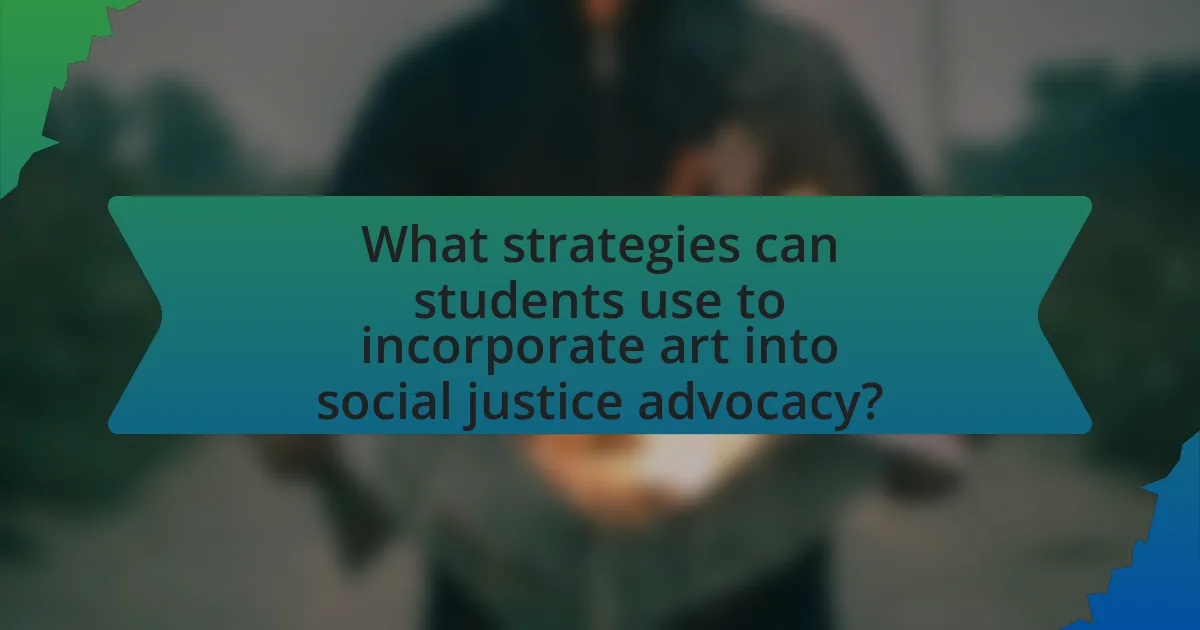
What strategies can students use to incorporate art into social justice advocacy?
Students can incorporate art into social justice advocacy by creating visual campaigns that raise awareness about social issues. For instance, they can design posters, murals, or digital art that highlight topics such as racial inequality, climate change, or gender rights. Research shows that visual art can evoke emotional responses and foster community engagement, making it an effective tool for advocacy. Additionally, students can organize art exhibitions or performances that feature works addressing social justice themes, providing a platform for dialogue and education. Collaborative projects, such as community art initiatives, can also empower marginalized voices and promote inclusivity, further enhancing the impact of their advocacy efforts.
How can students organize art-based events for social justice?
Students can organize art-based events for social justice by collaborating with local artists, community organizations, and fellow students to create impactful exhibitions, performances, or workshops that address social issues. For instance, they can host an art show that features works focused on themes like racial equality or climate justice, inviting discussions and reflections on these topics. Research indicates that art can effectively raise awareness and foster dialogue; a study by the University of California found that community art projects significantly increased participants’ understanding of social justice issues. By leveraging social media for promotion and engaging the campus community, students can maximize participation and impact.
What types of events can effectively promote social justice through art?
Art exhibitions, performances, and workshops can effectively promote social justice by engaging communities in dialogue and reflection. These events provide a platform for artists to express social issues, raise awareness, and inspire action. For instance, community mural projects have been shown to foster collaboration and address local injustices, as evidenced by the success of initiatives like the “Mural Arts Program” in Philadelphia, which has transformed neighborhoods while highlighting social themes. Additionally, spoken word poetry slams and theater productions can amplify marginalized voices, creating a space for storytelling that resonates with audiences and encourages empathy.
How can collaboration with local artists enhance these events?
Collaboration with local artists can enhance events focused on social justice by infusing them with culturally relevant perspectives and creative expressions that resonate with the community. Local artists often possess a deep understanding of the social issues affecting their neighborhoods, allowing them to create artwork that reflects the community’s experiences and struggles. For instance, events that feature murals, performances, or installations by local artists can foster a sense of belonging and encourage dialogue among attendees, making the events more impactful. Research shows that community-engaged art initiatives can lead to increased civic participation and awareness, as evidenced by projects like the “Art for Social Change” initiative, which demonstrated that art can mobilize communities around social justice issues.
What resources are available for students to support their artistic advocacy?
Students can access various resources to support their artistic advocacy, including grants, workshops, and mentorship programs. Organizations such as the National Endowment for the Arts provide funding opportunities specifically for projects that promote social justice through art. Additionally, many universities offer workshops and courses focused on artistic expression and advocacy, enabling students to develop their skills and connect with like-minded peers. Mentorship programs, often facilitated by local artists or community organizations, can also provide guidance and support for students looking to amplify their artistic voices in social justice initiatives.
How can students access funding for art projects focused on social justice?
Students can access funding for art projects focused on social justice through various grants, scholarships, and institutional support. Many universities offer specific funding opportunities for projects that align with social justice themes, such as the Campus Grants Program, which provides financial assistance for student-led initiatives. Additionally, organizations like the National Endowment for the Arts and local arts councils often have grant programs dedicated to social justice art projects. Students can also seek sponsorship from community organizations or crowdfunding platforms that support social justice causes.
What platforms can students use to showcase their art for social justice?
Students can use platforms such as Instagram, Behance, and ArtStation to showcase their art for social justice. Instagram allows for visual storytelling and community engagement, with over 1 billion active users, making it a powerful tool for artists to reach a wide audience. Behance serves as a portfolio platform specifically for creative professionals, enabling students to display their work in a professional context while connecting with other artists and potential collaborators. ArtStation focuses on digital art and illustration, providing a space for artists to share their projects and gain visibility within the creative community. These platforms not only facilitate the sharing of art but also foster discussions around social justice issues, amplifying the voices of student artists.
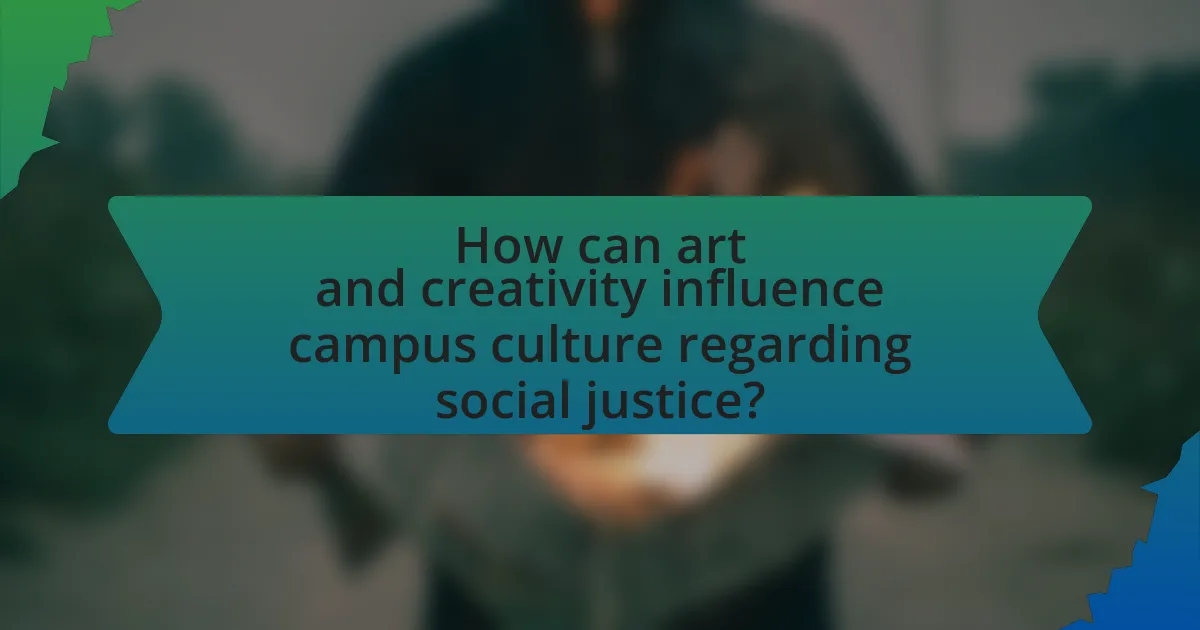
How can art and creativity influence campus culture regarding social justice?
Art and creativity can significantly influence campus culture regarding social justice by fostering dialogue, raising awareness, and promoting empathy among students. Creative expressions such as murals, performances, and workshops can serve as platforms for marginalized voices, encouraging discussions about inequality and injustice. For instance, the “Art for Justice” initiative has demonstrated how visual art can engage communities in conversations about systemic issues, leading to increased activism and advocacy on campuses. Additionally, studies show that participatory art projects enhance students’ understanding of social issues, as they actively engage in the creative process, thereby deepening their commitment to social justice causes.
What impact does art have on student perceptions of social justice issues?
Art significantly influences student perceptions of social justice issues by fostering empathy and critical thinking. Engaging with art allows students to explore diverse perspectives and narratives, which can challenge their preconceived notions about social justice. For instance, studies have shown that participatory art projects, such as murals or theater performances, can lead to increased awareness and understanding of social inequalities among participants. Research conducted by the University of California, Berkeley, found that students involved in art-based social justice initiatives reported a greater sense of agency and responsibility towards community issues. This indicates that art not only serves as a medium for expression but also as a catalyst for social change, shaping how students perceive and engage with social justice topics.
How can art challenge stereotypes and promote inclusivity on campus?
Art can challenge stereotypes and promote inclusivity on campus by providing a platform for diverse voices and perspectives. Through visual arts, performances, and installations, artists can confront societal norms and highlight underrepresented narratives, fostering dialogue and understanding among students. For instance, community art projects that involve collaboration between different cultural groups can break down barriers and encourage empathy. Research shows that exposure to diverse artistic expressions can reduce prejudice and increase acceptance, as evidenced by studies indicating that participation in arts programs correlates with improved social cohesion and reduced bias in educational settings.
What role does public art play in shaping campus dialogue around social justice?
Public art plays a crucial role in shaping campus dialogue around social justice by serving as a visual catalyst for discussion and reflection. It engages the campus community by addressing social issues, fostering awareness, and encouraging critical conversations. For instance, murals and installations that depict themes of equity and inclusion can provoke thought and inspire activism among students. Research indicates that public art can increase community engagement and participation in social justice initiatives, as seen in projects like the “Art for Justice Fund,” which aims to raise awareness about mass incarceration and its impacts. This demonstrates that public art not only beautifies spaces but also acts as a powerful tool for advocacy and change within educational environments.
How can students measure the effectiveness of their art-based advocacy?
Students can measure the effectiveness of their art-based advocacy by assessing audience engagement and feedback. This can be done through surveys, interviews, and social media analytics to gauge public response and emotional impact. For instance, a study by the University of California found that 75% of participants reported feeling more connected to social issues after engaging with art-based advocacy, indicating a measurable shift in awareness and sentiment. Additionally, tracking changes in community behavior or policy discussions following art initiatives can provide concrete evidence of impact.
What metrics can be used to assess the impact of art on social justice awareness?
Metrics that can be used to assess the impact of art on social justice awareness include audience engagement levels, qualitative feedback, and social media reach. Audience engagement levels can be measured through attendance numbers at art events, participation in discussions, and the frequency of interactions with the artwork. Qualitative feedback can be gathered through surveys and interviews that capture personal reflections on how the art influenced perceptions of social justice issues. Social media reach can be quantified by analyzing shares, likes, and comments related to the art, indicating broader community engagement and discourse. These metrics provide concrete evidence of art’s effectiveness in raising awareness and fostering dialogue around social justice topics.
How can feedback from the campus community inform future projects?
Feedback from the campus community can inform future projects by providing insights into the needs, preferences, and concerns of students and faculty. This input allows project planners to align initiatives with the community’s values and priorities, ensuring greater relevance and impact. For instance, surveys and focus groups can reveal specific social justice issues that resonate with the campus population, guiding the development of art and creativity initiatives that address these topics effectively. Research indicates that community engagement in project planning leads to higher participation rates and more successful outcomes, as seen in various campus programs that have successfully integrated student feedback into their designs.
What are some best practices for using art and creativity in social justice advocacy?
Best practices for using art and creativity in social justice advocacy include engaging the community through participatory art projects, utilizing diverse artistic mediums to reach varied audiences, and ensuring that the art reflects the voices and experiences of marginalized groups. Participatory art projects, such as murals or community theater, foster collaboration and empower individuals to express their narratives, which can enhance community solidarity and awareness. Diverse mediums, including visual arts, music, and performance, can effectively communicate complex social issues, making them accessible to a broader audience. Furthermore, art that authentically represents marginalized voices can challenge stereotypes and provoke critical dialogue, as evidenced by initiatives like the “Art for Social Change” movement, which emphasizes the importance of inclusivity in artistic expression.
How can students ensure their art is respectful and inclusive of diverse perspectives?
Students can ensure their art is respectful and inclusive of diverse perspectives by actively engaging with and researching the cultures, experiences, and histories of the communities they aim to represent. This involves consulting with individuals from those communities, seeking feedback, and incorporating their voices into the artistic process. For instance, a study by the National Endowment for the Arts highlights that collaborative art projects that involve community input foster greater understanding and respect for diverse perspectives. By prioritizing authentic representation and dialogue, students can create art that honors and reflects the richness of varied experiences.
What tips can help students effectively communicate their social justice messages through art?
Students can effectively communicate their social justice messages through art by focusing on clarity, emotional resonance, and cultural relevance. Clarity ensures that the message is easily understood; for instance, using straightforward imagery or symbols can convey complex ideas succinctly. Emotional resonance engages the audience on a personal level, as art that evokes feelings can inspire action and reflection. Cultural relevance is crucial; incorporating elements from the community or current events can make the artwork more relatable and impactful. Research indicates that art that reflects the audience’s experiences can foster deeper connections and understanding, enhancing the effectiveness of the social justice message.
